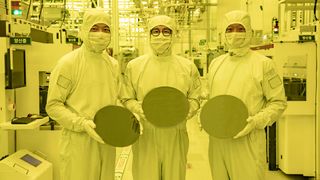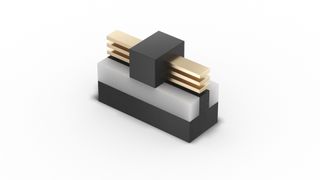Samsung beats Intel and TSMC to major chipmaking tech that'll one day power our gaming PCs
They're called gate-all-around transistors, and everyone's looking to use them in the near future.

Samsung is the first chipmaker to roll out a brand new technology, one which will eventually be used by all major chipmakers and find its way into all manner of computer chips, including those from Intel, Nvidia, and AMD. It's called gate-all-around (GAA), and it changes the way in which transistors, the building blocks of all our tech products, will be made.
GAA (sometimes referred to as GAAFET) is what will replace FinFET technology that is in widespread use today. It's a new technology that uses a gate wrapped around multiple transistor channels. That's quite a bit different to FinFET, which uses a single fin as a channel with a gate connected on three sides.
Why is that significant? GAA essentially enables stacking of multiple channels on top of one another; more channels, greater scaling capacity. That's why GAA is so key to extremely compact process nodes such as 3nm and 2nm. The other thing is that GAAFet channels can be adjusted in width, from wires to sheets, which can again help with shrinking down with each node and increasing performance.
Samsung calls its GAA technology "Multi-Bridge-Channel FET", or MBCFET for short, and its new 3nm process node with this new MBCFET technology is now in the initial production stage. This new MBCFET technology "defies the performance limitations of FinFET, improving power efficiency by reducing the supply voltage level, while also enhancing performance by increasing drive current capability," says Samsung.
The first generation 3nm process node out of Samsung aims to achieve a 45% reduction in power consumption, 23% faster performance, and take up 16% less space than its current 5nm process. From there, Samsung hopes to build chips with its second generation 3nm process that are 50% more efficient, 30% faster, and 35% smaller.
That's a serious step up that could lead to some tasty processors out of Samsung's partners at the time. Right now, Samsung has one major gaming client that we all know very well, and that's Nvidia. Samsung is responsible for manufacturing the RTX 30-series on its 8nm process node today.

Though whether Nvidia will stick around with Samsung for future cards is up in the air. It's rumoured that the green team could be making the switch back to TSMC for its 4nm process node, but it's not yet been confirmed by the company itself. This wouldn't be entirely unexpected, however. Nvidia used to tap TSMC for all its graphics cards needs but only recently made the switch to Samsung, which it had worked with only on some lower-end cards in the past.
The biggest gaming news, reviews and hardware deals
Keep up to date with the most important stories and the best deals, as picked by the PC Gamer team.
TSMC is the primary chipmaker for pretty much all of AMD's lineup, including CPUs and GPUs. This single chipmaker could become very important to PC gaming in the near future, then.

Best gaming PC: The top pre-built machines from the pros
Best gaming laptop: Perfect notebooks for mobile gaming
Samsung might be ahead for now, but TSMC won't lag far behind. In fact, all the major players have a version of GAA in the works, including Intel with its equivalent "RibbonFET", which will be an integral part of the 20A process node coming in 2024; and TSMC, which is planning to roll out something similar with its N2 process node in 2025. TSMC and Intel may announce early production of these chips before these given dates, now that Samsung has fired the starting pistol.
For today, however, it's Samsung, the company looking to take a chunk out of TSMC's booming business, that is able to claim the first victory.

Jacob earned his first byline writing for his own tech blog. From there, he graduated to professionally breaking things as hardware writer at PCGamesN, and would go on to run the team as hardware editor. He joined PC Gamer's top staff as senior hardware editor before becoming managing editor of the hardware team, and you'll now find him reporting on the latest developments in the technology and gaming industries and testing the newest PC components.
Most Popular





